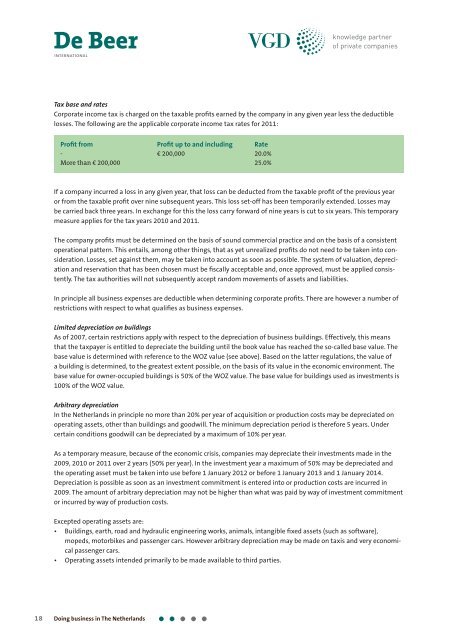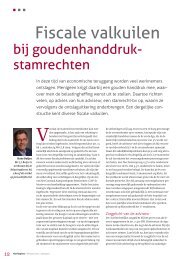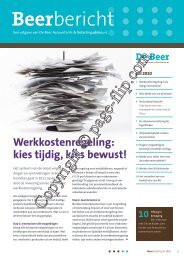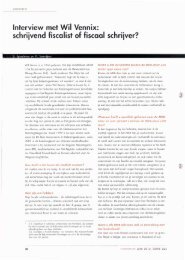De Beer
De Beer
De Beer
- No tags were found...
You also want an ePaper? Increase the reach of your titles
YUMPU automatically turns print PDFs into web optimized ePapers that Google loves.
<strong>De</strong> <strong>Beer</strong>INTERNATIONALknowledge partnerof private companiesTax base and ratesCorporate income tax is charged on the taxable profits earned by the company in any given year less the deductiblelosses. The following are the applicable corporate income tax rates for 2011:Profit from Profit up to and including Rate- € 200,000 20.0%More than € 200,000 25.0%If a company incurred a loss in any given year, that loss can be deducted from the taxable profit of the previous yearor from the taxable profit over nine subsequent years. This loss set-off has been temporarily extended. Losses maybe carried back three years. In exchange for this the loss carry forward of nine years is cut to six years. This temporarymeasure applies for the tax years 2010 and 2011.The company profits must be determined on the basis of sound commercial practice and on the basis of a consistentoperational pattern. This entails, among other things, that as yet unrealized profits do not need to be taken into consideration.Losses, set against them, may be taken into account as soon as possible. The system of valuation, depreciationand reservation that has been chosen must be fiscally acceptable and, once approved, must be applied consistently.The tax authorities will not subsequently accept random movements of assets and liabilities.In principle all business expenses are deductible when determining corporate profits. There are however a number ofrestrictions with respect to what qualifies as business expenses.Limited depreciation on buildingsAs of 2007, certain restrictions apply with respect to the depreciation of business buildings. Effectively, this meansthat the taxpayer is entitled to depreciate the building until the book value has reached the so-called base value. Thebase value is determined with reference to the WOZ value (see above). Based on the latter regulations, the value ofa building is determined, to the greatest extent possible, on the basis of its value in the economic environment. Thebase value for owner-occupied buildings is 50% of the WOZ value. The base value for buildings used as investments is100% of the WOZ value.Arbitrary depreciationIn the Netherlands in principle no more than 20% per year of acquisition or production costs may be depreciated onoperating assets, other than buildings and goodwill. The minimum depreciation period is therefore 5 years. Undercertain conditions goodwill can be depreciated by a maximum of 10% per year.As a temporary measure, because of the economic crisis, companies may depreciate their investments made in the2009, 2010 or 2011 over 2 years (50% per year). In the investment year a maximum of 50% may be depreciated andthe operating asset must be taken into use before 1 January 2012 or before 1 January 2013 and 1 January 2014.<strong>De</strong>preciation is possible as soon as an investment commitment is entered into or production costs are incurred in2009. The amount of arbitrary depreciation may not be higher than what was paid by way of investment commitmentor incurred by way of production costs.Excepted operating assets are:• Buildings, earth, road and hydraulic engineering works, animals, intangible fixed assets (such as software),mopeds, motorbikes and passenger cars. However arbitrary depreciation may be made on taxis and very economicalpassenger cars.• Operating assets intended primarily to be made available to third parties.18 Doing business in The Netherlands







